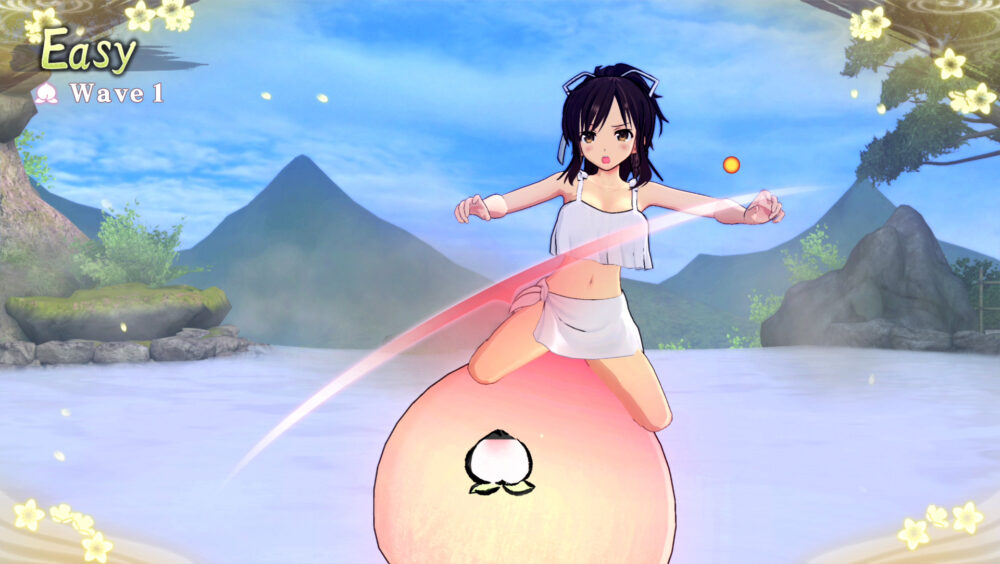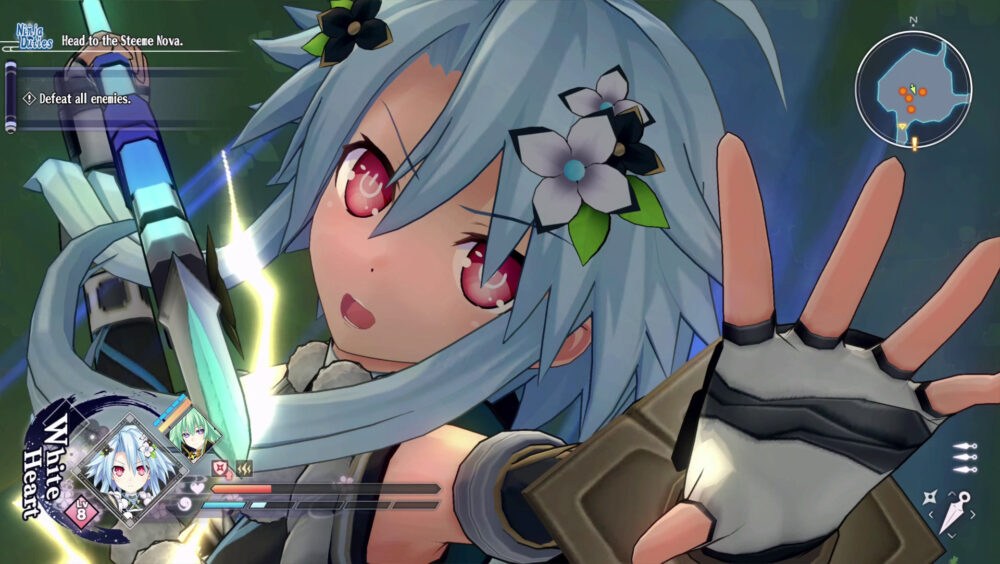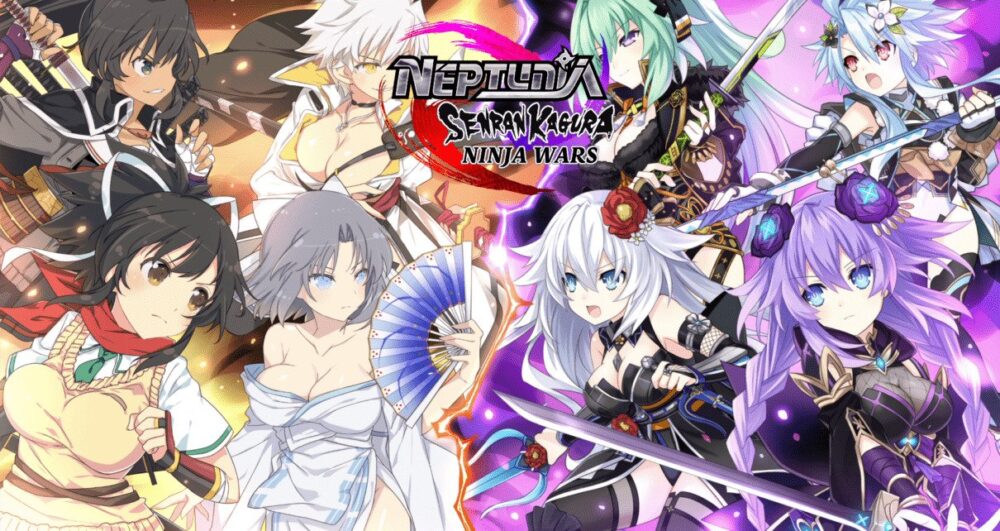In the last decade or so there’s been a rising tide of crossovers taking over media as a whole. I like to call it the MCU effect. No longer is a franchise able to stay in its own line for too long before an inevitable crossover outing. Nintendo fans have Smash Bros. Comic book fans have the MCU and DCEU. Now, fan-service fans have their own bewildering crossover to behold – Neptunia X Senran Kagura: Ninja Wars. Created jointly by Compile Heart, Tamsoft and Aquire, NxSK brings together the characters and tone of the Hyperdimension Neptunia series and the gameplay and themes of the Senran Kagura series.
At first glance, it doesn’t sound like the most obvious mashup. Neptunia is an RPG series all about contrasting light-hearted fun with darker themes and topping it off with a heavy layer of satirical games-industry commentary. Senran Kagura – on the other hand – is mostly made up of ninja hack and slashes with a slice-of-life style, which also prominently features very busty fighters and destructible clothing. Neptunia is cute with some flirty fan service. Senran Kagura contains very impressive and visible breast physics. It’s not an obvious combination, but it seems that somehow they’ve made it work?

It all starts in the midst of a heavy battle between the representatives of two warring factions – Heartland and Marveland – who constantly fight for control of Gamninjustri. Representing Heartland are the four ninja goddesses – the main cast of Neptunia – and representing Marveland are Asuka, Homura, Yumi and Miyabi – four prominent Senran Kagura girls. Their strangely friendly battle is interrupted by Yoh Gamer and her Steme Legion (I wonder who they are parodying here…) who announce their intentions to take over. The story then follows the eight girls (plus one original character and a gender-bent Goh from Ps2 title Shinobido) as they fight across the world to take down a mechanical army of Ninjas. As with many crossover titles, much of the initial plot simply feels like an excuse to put these strong characters into one world and is resultantly a bit shallow. However, I will give the developers credit for integrating the two worlds into one as well as they have. You can clearly see the Neptunia influence on the world design and you see many Nep’ characters within it, but it’s impossible to miss the strong ninja theming here and many characters have had to be dialled back to fit it. After the initial hurdle of establishing why these enemy characters are willing to work together, the story picks up and introduces variant versions of many beloved characters. It isn’t particularly long, but it’s fun whilst it lasts.
As you progress you’ll go through a number of dungeons areas fighting monsters and taking part in very light puzzle solving. After each mission, the story will progress and you’ll be sent back to the town menu to restock and equip your team – just as you would see in a Nep game. Thankfully, these breaks help the pacing by giving the player time to reflect; something that doesn’t happen often inside the actual dungeons. These breaks also give you a chance to play side-missions in previously visited areas with the mission starting immediately once selected – a much-appreciated quality of life change from previous Nep games in which you had to make your way over to the area separately.

The combat itself, in comparison, is more reminiscent of the latter title. Your team consists of two characters – a leader and a partner who can be swapped at will – and you use a mixture of combo attacks, ninja skills, ranged attacks and power-up abilities to decimate your enemies. Your basic attack can be chained to create combos alongside character-swapping and ranged attacks, but the highlight attacks are the ninja arts, which consume the energy you gain from the more basic combos. These can be used alone or combo’d to grant later attacks extra effects, and as you level up you are able to unlock more choices to switch out. I thoroughly enjoyed working out useful attack patterns to help take out tougher enemies, though I did feel like some characters were more useful than others in terms of their ninja art skills. In addition, the elemental power-up system allows limited transformations up to five times per mission, providing the choice between extra damage, health regen, speed or defence. I found these really compelling to use, as it forced me to think more tactically than I otherwise would have. I also liked how the outfits of the characters change to match the element for a short time. There isn’t a huge amount of monster variety, with recolours abound, but thankfully the combat was satisfying enough that I didn’t really find this too much of an issue.
Another element of the combat I enjoyed was how differently each character played. The exp system seems to level them up relatively evenly as well, which allowed me to experience with different girls throughout the adventure. It’s very easy to fall into the trap of having almost-identically-playing characters, but they’ve done well in how they’ve varied not just their attacks, but their entire flow.

In the town menu, it’s clear that the interface is straight from Neptunia and it presents a number of locations to visit across a world map. Between missions, you can swap out your team of two girls from the roster of ten, swap out weapons and abilities and use spirit gems to give each character small boosts. There is also a talk menu; allowing for short character interactions; an area in which to access the side-quests; and the mandatory “fan-service” minigame.
This part has seemingly been the biggest point of contention for many fans, as the fan service itself is limited at best. Personally, I’m glad that I can play a game with this kind of feel without being forced to play mini-games which make me feel like a pervert, but considering the history of the two series,’ I can understand why the lack of easily-viewable boobs and butts may frustrate veterans. This minigame is a simple balance trial which provides a temporary HP boost, and whilst the girls only wear towels they remain very much covered up for once. This trend of having less fan service also extends to the rest of the experience, which forgoes the clothes-destruction of SK games and dials down the flirty banter a degree. The girls are still very busty and quite scantily clad, but in comparison, it’s very tame. Possibly the most revealing outfit belongs to the only original playable character – Yuuki – who practically bursts out of her outfit as she performs her cat-like attacks. Coincidentally, she’s also my favourite to play with due to her speed. That’s the only reason. Honest.

The game can look a little rough at times on Switch. It’s not ugly by any means, but it’s very much at the same level as previous Nep games. The 2D art and 3D character designs are great as always, but the environmental textures leave some to be desired and dungeons can sometimes just feel a little empty and lifeless. The sound design however is excellent and really reflects the feudal Japanese tone they were going for.
Overall, Neptunia X Senran Kagura: Ninja Wars is a bit of a mixed bag. For the most part, it is a blast to run through dungeons slicing down robots and using flashy abilities. The character designs are great and the combat feels really good, as does the whole loop. I just can’t help but feel like this could have been more though. Maybe I’ve been spoilt by successive Warriors spinoffs, but there’s not as much content here as I would have hoped from a Nep product and not as much depth as I would have hoped from a KS product. Add in the various features some would consider to be missing (clothes destruction, fan service etc,) the somewhat limited roster and the graphical issues and it starts to feel a little bit like an incomplete experience. Whilst this could have been a celebration of both series’, it instead fell short of either, and I can’t help but feel like it could have been better. If you love both series, you’ll like this, but be prepared to accept that it doesn’t reach the heights of either. It’s alright, but it could – and should – have been great.
Publisher: Idea Factory
Developers: Tamsoft, Compile Heart
Platforms: Nintendo Switch, PlayStation 4, Microsoft Windows
Reviewed on PC on Steam.
Enjoy the review? want to read more of our reviews? then click right here to be whisked away to the realm of our opinions.








You must be logged in to post a comment.